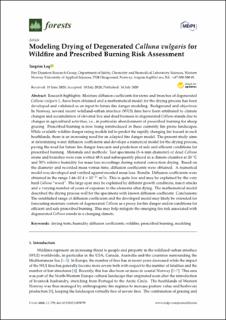| dc.contributor.author | Log, Torgrim | |
| dc.date.accessioned | 2020-12-07T08:43:33Z | |
| dc.date.available | 2020-12-07T08:43:33Z | |
| dc.date.created | 2020-07-16T19:06:43Z | |
| dc.date.issued | 2020 | |
| dc.identifier.citation | Log, T. (2020). Modeling drying of degenerated calluna vulgaris for wildfire and prescribed burning risk assessment. Forests, 11(7). | en_US |
| dc.identifier.issn | 1999-4907 | |
| dc.identifier.uri | https://hdl.handle.net/11250/2712086 | |
| dc.description.abstract | Research highlights: Moisture diffusion coefficients for stems and branches of degenerated Calluna vulgaris L. have been obtained and a mathematical model for the drying process has been developed and validated as an input to future fire danger modeling. Background and objectives: In Norway, several recent wildland–urban interface (WUI) fires have been attributed to climate changes and accumulation of elevated live and dead biomass in degenerated Calluna stands due to changes in agricultural activities, i.e., in particular abandonment of prescribed burning for sheep grazing. Prescribed burning is now being reintroduced in these currently fire prone landscapes. While available wildfire danger rating models fail to predict the rapidly changing fire hazard in such heathlands, there is an increasing need for an adapted fire danger model. The present study aims at determining water diffusion coefficients and develops a numerical model for the drying process, paving the road for future fire danger forecasts and prediction of safe and effcient conditions for prescribed burning. Materials and methods: Test specimens (3–6 mm diameter) of dead Calluna stems and branches were rain wetted 48 h and subsequently placed in a climate chamber at 20 °C and 50% relative humidity for mass loss recordings during natural convection drying. Based on the diameter and recorded mass versus time, diffusion coefficients were obtained. A numerical model was developed and verified against recoded mass loss. Results: Diffusion coefficients were obtained in the range 1.66–10.4 _ 1011 m2/s. This is quite low and may be explained by the very hard Calluna “wood”. The large span may be explained by different growth conditions, insect attacks and a varying number of years of exposure to the elements after dying. The mathematical model described the drying process well for the specimens with known diffusion coefficient. Conclusions: The established range of diffusion coefficients and the developed model may likely be extended for forecasting moisture content of degenerated Calluna as a proxy for fire danger and/or conditions for efficient and safe prescribed burning. This may help mitigate the emerging fire risk associated with degenerated Calluna stands in a changing climate. | en_US |
| dc.language.iso | eng | en_US |
| dc.publisher | MDPI | en_US |
| dc.rights | Navngivelse 4.0 Internasjonal | * |
| dc.rights.uri | http://creativecommons.org/licenses/by/4.0/deed.no | * |
| dc.subject | drying tests | en_US |
| dc.subject | humidity diffusion coefficients | en_US |
| dc.subject | wildfire | en_US |
| dc.subject | prescribed burning | en_US |
| dc.subject | modeling | en_US |
| dc.title | Modeling Drying of Degenerated Calluna vulgaris for Wildfire and Prescribed Burning Risk Assessment | en_US |
| dc.type | Peer reviewed | en_US |
| dc.type | Journal article | en_US |
| dc.description.version | publishedVersion | en_US |
| dc.rights.holder | © 2020 by the author | en_US |
| dc.source.pagenumber | 18 | en_US |
| dc.source.volume | 11 | en_US |
| dc.source.journal | Forests | en_US |
| dc.source.issue | 7 | en_US |
| dc.identifier.doi | 10.3390/f11070759 | |
| dc.identifier.cristin | 1819640 | |
| dc.relation.project | Norges forskningsråd: 298993 | en_US |
| cristin.ispublished | true | |
| cristin.fulltext | original | |
| cristin.qualitycode | 1 | |

